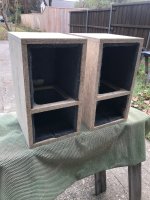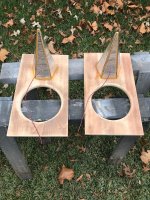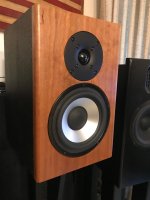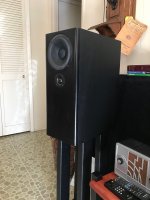I think I lost those measurements due to a hard drive failure, but this post has some response curves.
https://www.diyaudio.com/community/threads/10f-8424-rs225-8-fast-waw-ref-monitor.273524/post-7077022
https://www.diyaudio.com/community/threads/10f-8424-rs225-8-fast-waw-ref-monitor.273524/post-7077022
Hi Keantoken, could you please you post the driver/baffle layout you used with your crossover.
And the size of the TC9FD sub enclosure if you know it.
Cheers
And the size of the TC9FD sub enclosure if you know it.
Cheers
Keantoken is using the standard baffle and sealed cabinet dimensions described in post 1. 10in wide and 7in CTC spacing between the woofer and tweeter. Probably an 11in tall sports cone for the full range rear chamber?
The subchamber is pyramidal in shape constructed from flat sheets and I think it has aluminum tar sheets on the outside. I've seen the construction method somewhere in this thread. I didn't make these boxes so I don't have the construction info on hand.
I measured the crossover response.


Above is the preferred listening position (from listening) because the baffle diffraction and tweeter ringing is concentrated on-axis. This is what it looks like more on-axis.


Looking at the impulse responses again, it looks like the problem is coming from diffraction, not ringing since the roughness does not gradually decay like ringing would.
Above is the preferred listening position (from listening) because the baffle diffraction and tweeter ringing is concentrated on-axis. This is what it looks like more on-axis.
Looking at the impulse responses again, it looks like the problem is coming from diffraction, not ringing since the roughness does not gradually decay like ringing would.
Last edited:
Looks pretty good to me. I hope they are working out for you. Attached are pics of them under construction. I'm currently using Neil Blanchard's transmission line speakers that work out well with my tube amp. 5 sided HF enclosures deadened with a Dynamat substitute. No idea as to internal volume. Have fun!
Attachments
They are the best speakers I own right now. Clarity does not fall apart on loud passages. With the new crossover the life-like clarity means music is enjoyable without any lack of detail. The detail comes out naturally, so you can just casually hear acoustic details of the recording and space while enjoying the music. Without good tonal balance, recording quirks like proximity effect are indistinguishable from the tone of the instruments and voices, making them artificial and unreal. But with everything in balance and clear, you can hear the voice and you can also hear the microphone or the recording environment. But these things don't monopolize your attention, so you hear what you place your attention on, which is what you enjoy. You can hear as much detail as you want just by placing your attention on it. Just as in real life, we don't notice everything we hear unless we pay attention to it.
Glad to hear it. Wish I had the technical prowess to measure/simulate/design but, oh well. I admire your ability. Built many other published designs since then. My favorites have been Michael Chua's Dove and Neil Blanchard's MLTL. Both sound great using economical drivers.
Attachments
What crossover modifications are needed if you're going to swap the woofer on these? Assuming the response is smooth through the crossover, is it just changing R values to get the right sensitivity? I'd like to build something like this but smaller so it can lie on its side under my PC monitors, which limits me to 1-2 5" woofers at most instead of a single 8".
I measured the crossover response.
View attachment 1190872
View attachment 1190877
Above is the preferred listening position (from listening) because the baffle diffraction and tweeter ringing is concentrated on-axis. This is what it looks like more on-axis.
View attachment 1190875
View attachment 1190878
Looking at the impulse responses again, it looks like the problem is coming from diffraction, not ringing since the roughness does not gradually decay like ringing would.
This looks great Keantoken. I linked your schematic in post 1 so others can easily find this for future TC9FD based builds.
Great stuff. I'll be building a pair (10F8424 & RS225-8 (with XPS first)
Love the WAW (or FAST) concept, although I always thought it was generally when a woofer and mid-tweeter (widebander) were crossed down closer to the bottom of the "telephone line band" (300hZ).
I think I understand some of what a 2nd order crossover can do to disrupt phase and IR (compared to a well sorted 1st order slope)... but Im wondering if these drawbacks are nearly as objectionable crossing over closer to most listening rooms "shroeder frequency"- right around 150-300hZ (unless arena sized rooms lol). Phase and timing are usually a bloody mess down there regardless.
So id like to compare
I saw an example of 2nd order slope on page 1 of this thread using dsp. The FR showed 10db lower at 100hZ and 50hZ compared to the 1st order slope.
IME this would certainly result in a higher average SPL before the speaker craps out...
Is there anywhere in this monstrous thread where there might be a schematic and/or BOM for a successful 2nd order (passive not dsp) crossover down around 400-500hZ? for this speaker?
Love the WAW (or FAST) concept, although I always thought it was generally when a woofer and mid-tweeter (widebander) were crossed down closer to the bottom of the "telephone line band" (300hZ).
I think I understand some of what a 2nd order crossover can do to disrupt phase and IR (compared to a well sorted 1st order slope)... but Im wondering if these drawbacks are nearly as objectionable crossing over closer to most listening rooms "shroeder frequency"- right around 150-300hZ (unless arena sized rooms lol). Phase and timing are usually a bloody mess down there regardless.
So id like to compare
I saw an example of 2nd order slope on page 1 of this thread using dsp. The FR showed 10db lower at 100hZ and 50hZ compared to the 1st order slope.
IME this would certainly result in a higher average SPL before the speaker craps out...
Is there anywhere in this monstrous thread where there might be a schematic and/or BOM for a successful 2nd order (passive not dsp) crossover down around 400-500hZ? for this speaker?
The passive crossover for this speaker is 1st order at 900Hz. It’s on post #1 and has been extensively tested and used by many many people. You might try it first before doing your own thing to get a reference. There are variants for B80 and TC9FD and even RS100. The TC9FD by Keantoken goes quite a bit higher up but from what I understand it sounds great. Because of the first order slope, even at 900Hz, this is still a FAST design.
I have not made a second order at 300Hz for this speaker as much of the magic is the mid bass power that one gets with an 8in woofer providing the chest punch from 100Hz to 500Hz.
This is the basic crossover.
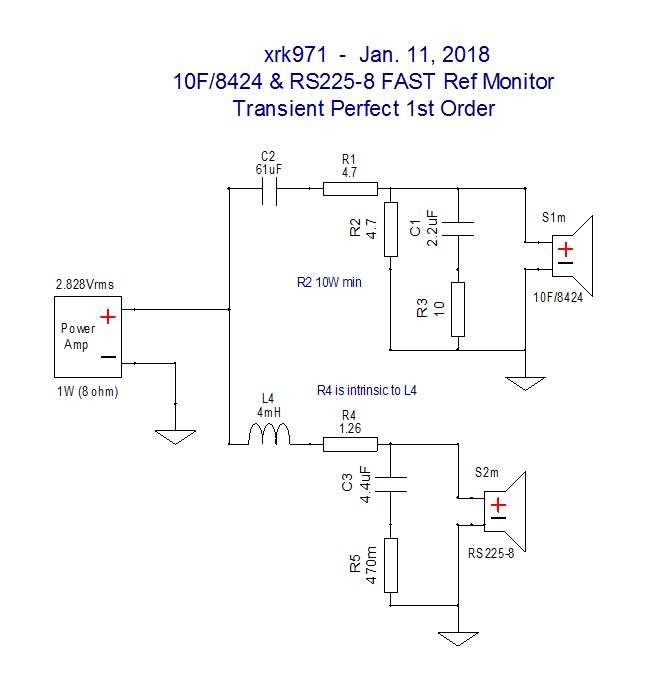
Frequency Response of XO:
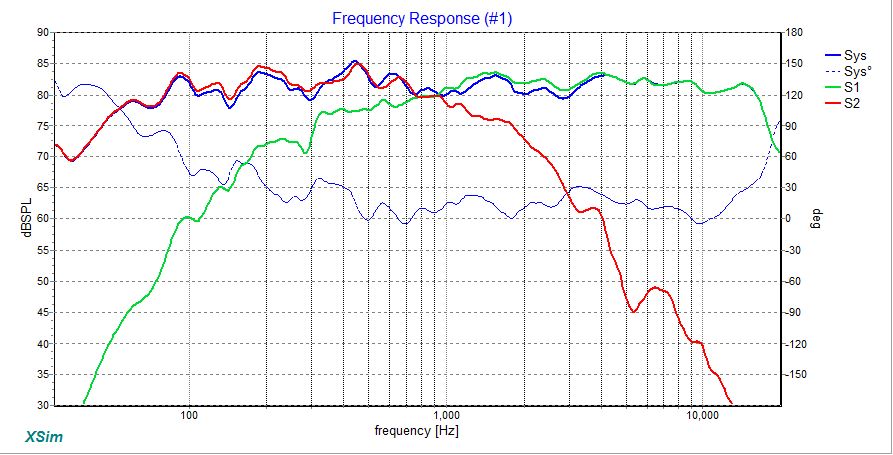
I have not made a second order at 300Hz for this speaker as much of the magic is the mid bass power that one gets with an 8in woofer providing the chest punch from 100Hz to 500Hz.
This is the basic crossover.
Frequency Response of XO:
Thank you X
Yes I’m building the known 900hz 1st order slope first using 1” extruded polystyrene
Yes I’m building the known 900hz 1st order slope first using 1” extruded polystyrene
I don't mean to highjack...but this thread is about a "transient perfect loudspeaker" and I believe step response has a lot to do with it....
Has anyone seen this and is there any truth to it?-
https://audiojudgement.com/loudspea...eaker step response is,of more than 2 drivers.
Has anyone seen this and is there any truth to it?-
https://audiojudgement.com/loudspea...eaker step response is,of more than 2 drivers.
Yes, the step response is the key evidence that this speaker is transient perfect. See the step response plot in Post 1:
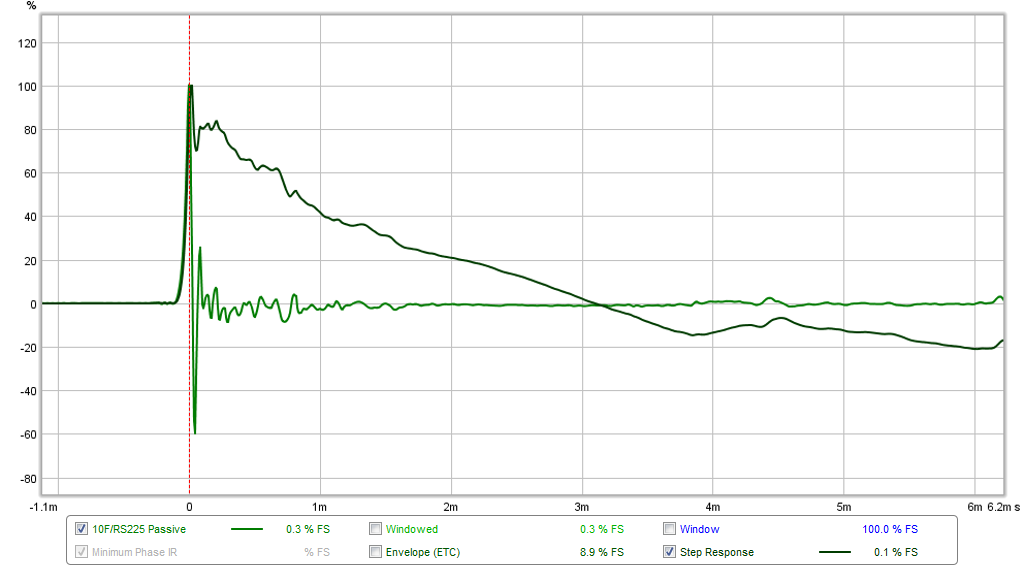
You can measure this yourself after you build this speaker. Get a microphone and REW and place mic on top woofer axis.
Corresponding to this right triangle shaped step response is a frequency response phase that is relatively flat:
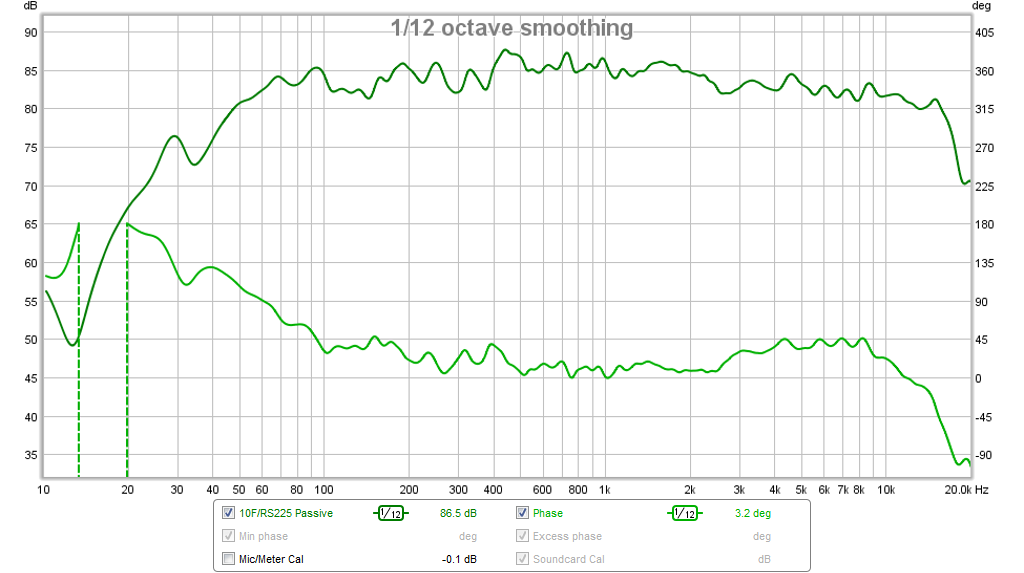

You can measure this yourself after you build this speaker. Get a microphone and REW and place mic on top woofer axis.
Corresponding to this right triangle shaped step response is a frequency response phase that is relatively flat:

Heres a much more thorough description of step response and its importance (in the authors opinion of course)-
https://www.vandersteen.com/media/files/APJ Files/APJ13_Proof.pdf
https://www.vandersteen.com/media/files/APJ Files/APJ13_Proof.pdf
- Home
- Loudspeakers
- Full Range
- 10F/8424 & RS225-8 FAST / WAW Ref Monitor
